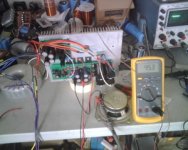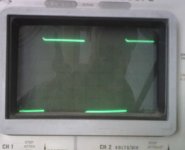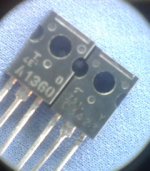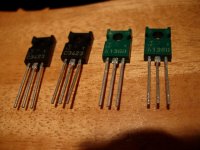Sheldon said:
The schematic in post 8 is a clear as it can be, 39v frontend, 34v output. Either way, the calculation is straightforward.
Sheldon
OK. That's DC. I was posting transformer AC. And you posted 34vac in post 738
pooge said:
OK. That's DC. I was posting transformer AC. And you posted 34vac in post 738
My bad. Yes, 34V DC, as I stated in my original post. I made it 34vac in my reply to your post, brain on autopilot. Sorry for the confusion.
Sheldon
Up and running. Makes music too. Now time to get the enclosure worked out.
One question: The transformer has dual windings. So choice of one or two bridges per channel. any strong opinions either way?
Sheldon
Edit: Don't know that it's necessarily a problem, but it doesn't like to be messed with. I left the input open. But if I touch it with a probe or lead it likes to oscillate and blow fuses (5A rail). A little buzz though the speaker when I do this, but nothing crazy, so it must be HF.
One question: The transformer has dual windings. So choice of one or two bridges per channel. any strong opinions either way?
Sheldon
Edit: Don't know that it's necessarily a problem, but it doesn't like to be messed with. I left the input open. But if I touch it with a probe or lead it likes to oscillate and blow fuses (5A rail). A little buzz though the speaker when I do this, but nothing crazy, so it must be HF.
Attachments
Sheldon said:One question: The transformer has dual windings. So choice of one or two bridges per channel. any strong opinions either way?
Originally posted by Nelson Pass
Most customers want total silence from the amplifier, including
mechanical noise. If there is not complete matching between the
secondary coils and only 1 rectifier bridge, any net DC imbalance
between the current of the + supply and the - will tend to
saturate the core of the transformer and create noise. This is
seen for quite low current differences and can also show up with
low frequency output. Using two bridges eliminates the problem.
Sheldon said:
Edit: Don't know that it's necessarily a problem, but it doesn't like to be messed with. I left the input open. But if I touch it with a probe or lead it likes to oscillate and blow fuses (5A rail). A little buzz though the speaker when I do this, but nothing crazy, so it must be HF.
It is a problem! I suspect occasional HF oscillations in CFP drivers.
How much current do you flow through CFP driver, master and slave transistors? Also, what transistors do you use?
Thanks pacificblue. Two bridges it is.
Thanks Mihai.
Voltage drop over R17 is 0.358V (2.4mA)
R5 is 12R, voltage drop is 1.275V (106mA).
Voltage drop over R6 is 0.596, R41 is 0.574
Transistors are 2SC3428Y:, 2SA1360O(couldn't get Y, so matched as close as I could).
Drivers are MJE15035,15034
R32, etc. are 0.1R, bias is 17mA (varies in a range from 16 to 19). Offset is about 7mA. Similar for all four boards.
OPT are MJL3201,1302
Sheldon
roender said:It is a problem! I suspect occasional HF oscillations in CFP drivers.
How much current do you flow through CFP driver, master and slave transistors? Also, what transistors do you use?
Thanks Mihai.
Voltage drop over R17 is 0.358V (2.4mA)
R5 is 12R, voltage drop is 1.275V (106mA).
Voltage drop over R6 is 0.596, R41 is 0.574
Transistors are 2SC3428Y:, 2SA1360O(couldn't get Y, so matched as close as I could).
Drivers are MJE15035,15034
R32, etc. are 0.1R, bias is 17mA (varies in a range from 16 to 19). Offset is about 7mA. Similar for all four boards.
OPT are MJL3201,1302
Sheldon
I'm gonna make the fuse company happy if I do too much more testing. I'll poke around with the output unpowered. Amp seems stable on its own, but it's hard to find where the problem is. If I just unplug the input from the signal generator, and try to plug it back in with the amp on, the rail fuses go. Yes, I know, not generally considered good practice to connect and disconnect with the amp on, but it shouldn't oscillate severely, that easily. I'm not sure how to check without the fuses going.
Do these look legit? Got them here: http://www.bdent.com/search/part.jsp?partnum=2SA1360#
Sheldon
Do these look legit? Got them here: http://www.bdent.com/search/part.jsp?partnum=2SA1360#
Sheldon
Attachments
With the output unpowered, all the voltages/currents check out for the front end. Currents for the back cascode/mirror (R15-18) with the outputs powered are very close to the unpowered state. Didn't dare poke around to much in front of that with output power, as that's when the fuses go.
Sheldon
Sheldon
roender said:Your A1360 seems to be fake
This could be a problem if the chip inside don't have low Cob
This, of course, begs the question: Anyone know where I can get genuine parts, this time Y versions?
Sheldon
Hi,
Looks very genuine to me.Your A1360 seems to be fake
I have powered up the front end successfully. Checked voltages and feedback using the suggestons here a what I did before and all worked OK.
I have since powered up the output stage succesfully, but without a bias voltage coming from the unpowered front end. Again voltages appear to be OK.
BUT,
if I power up both stages from a common PSU in turn supplied by a light bulb tester, it motor boats.
Back to a gentler start up.
Power up the output stage and very slowly bring up the input stage using a variac and lightbulb tester and it comes on OK.
Power up the front end and slowly bring up the output stage and I can see the two stages hunting with the current swinging in the output stage from near zero amperes to near fuse rating. Turn it up a little too quickly and the fuse blows.
Turn it up VERY SLOWLY and I can get full voltage on it.
I dare not remove the light bulb tester which comes on and off at ~0.3Hz cycles for fear of damaging the amp.
That all came happened about a month ago and I have left it aside while I re-think how to get it safely up to working quiescent voltage without killing all Roender's good work.
This symptom of fuse blowing seems very similar to what Sheldon is experiencing.
Any thoughts from the ether?
I have since powered up the output stage succesfully, but without a bias voltage coming from the unpowered front end. Again voltages appear to be OK.
BUT,
if I power up both stages from a common PSU in turn supplied by a light bulb tester, it motor boats.
Back to a gentler start up.
Power up the output stage and very slowly bring up the input stage using a variac and lightbulb tester and it comes on OK.
Power up the front end and slowly bring up the output stage and I can see the two stages hunting with the current swinging in the output stage from near zero amperes to near fuse rating. Turn it up a little too quickly and the fuse blows.
Turn it up VERY SLOWLY and I can get full voltage on it.
I dare not remove the light bulb tester which comes on and off at ~0.3Hz cycles for fear of damaging the amp.
That all came happened about a month ago and I have left it aside while I re-think how to get it safely up to working quiescent voltage without killing all Roender's good work.
This symptom of fuse blowing seems very similar to what Sheldon is experiencing.
Any thoughts from the ether?
- Home
- Amplifiers
- Solid State
- RMI-FC100, a single stage audio power amplifier



